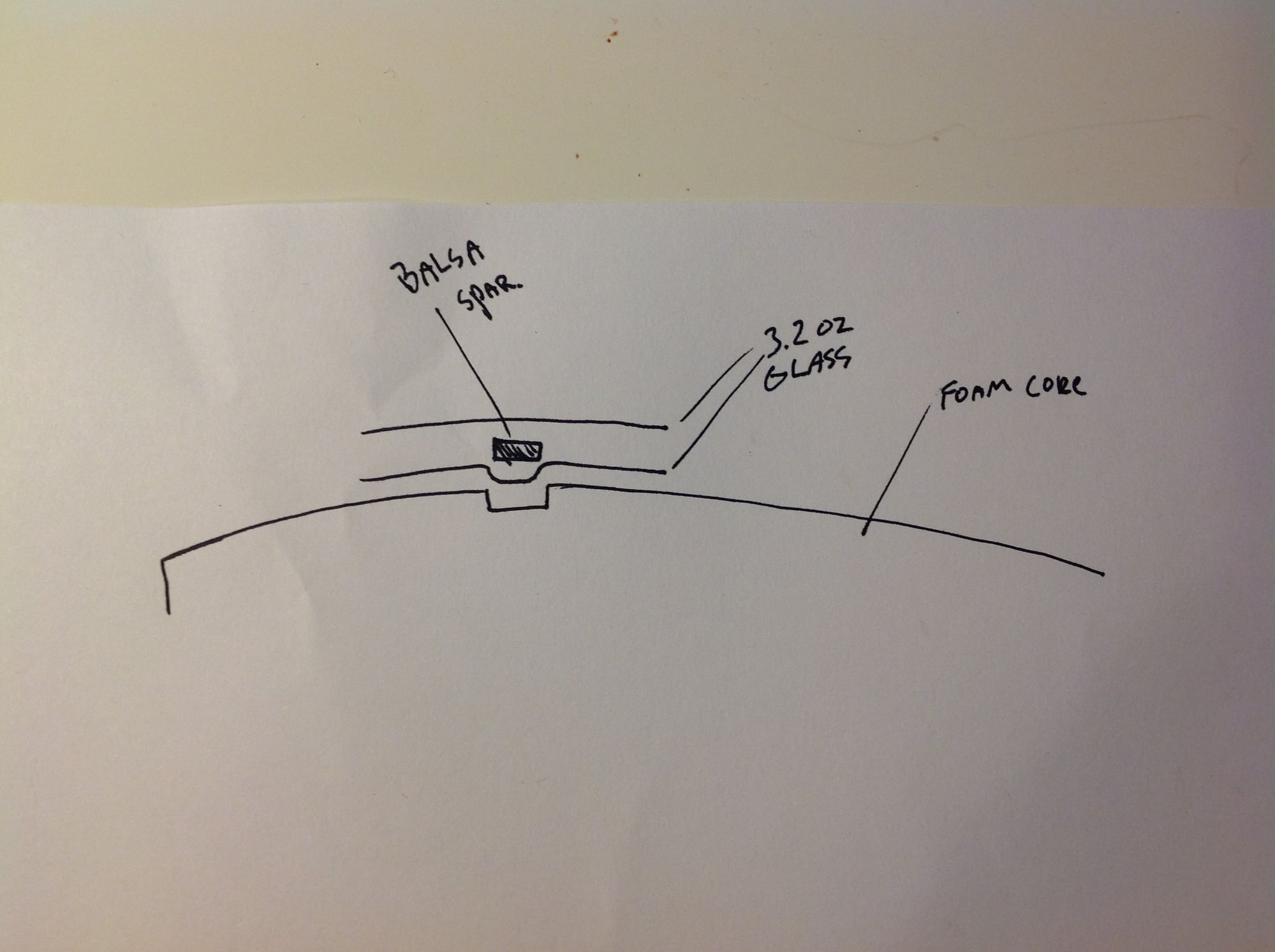Foam core blasa sheeting 43" sport wing - does it works
#1
Banned
Thread Starter
Hi,
I'm scratch building balsa planes sometimes. This time I was thinking to make the wing using lightweight (white )foam core sheeted with 1.5mm ( 1/16") balsa. Than cover with some oracover or smilar.
My concern is - would it become too heavy for a small plane of 1100mm (43" ) wingspan ?
Could you share some technique to reduce weight or alternatives of laminating foam core that would reduce weight?
I can also think of laminating with fiberglass but I expect that may become even heavier than balsa sheeting.
Thanks
I'm scratch building balsa planes sometimes. This time I was thinking to make the wing using lightweight (white )foam core sheeted with 1.5mm ( 1/16") balsa. Than cover with some oracover or smilar.
My concern is - would it become too heavy for a small plane of 1100mm (43" ) wingspan ?
Could you share some technique to reduce weight or alternatives of laminating foam core that would reduce weight?
I can also think of laminating with fiberglass but I expect that may become even heavier than balsa sheeting.
Thanks
#2

My Feedback: (29)
Foam wings can be done very light. I recently did a 1.9 meter wing that came out at 280g. Selecting light balsa will help but the main weight savings is the technique and products used to apply the sheeting. My method, tape the balsa sheeting together, no need to glue them together. Sand the foam cores smooth, you want maximum contact area between the sheeting and cores. Apply epoxy laminating resin to the sheeting opposite side as the tape. You only need to apply enough to dampen the wood. You want just a light sheen, any spots that gloss has too much resin. Tape the sheeting to the cores, place back into the blocks the cores were cut from. My preference is to place in a vacuum bag and pull 5" of vacuum. You can also place on a flat table, place a flat peice of wood on top and apply weight. Using a minimal amount of laminating epoxy will produce light weight parts.
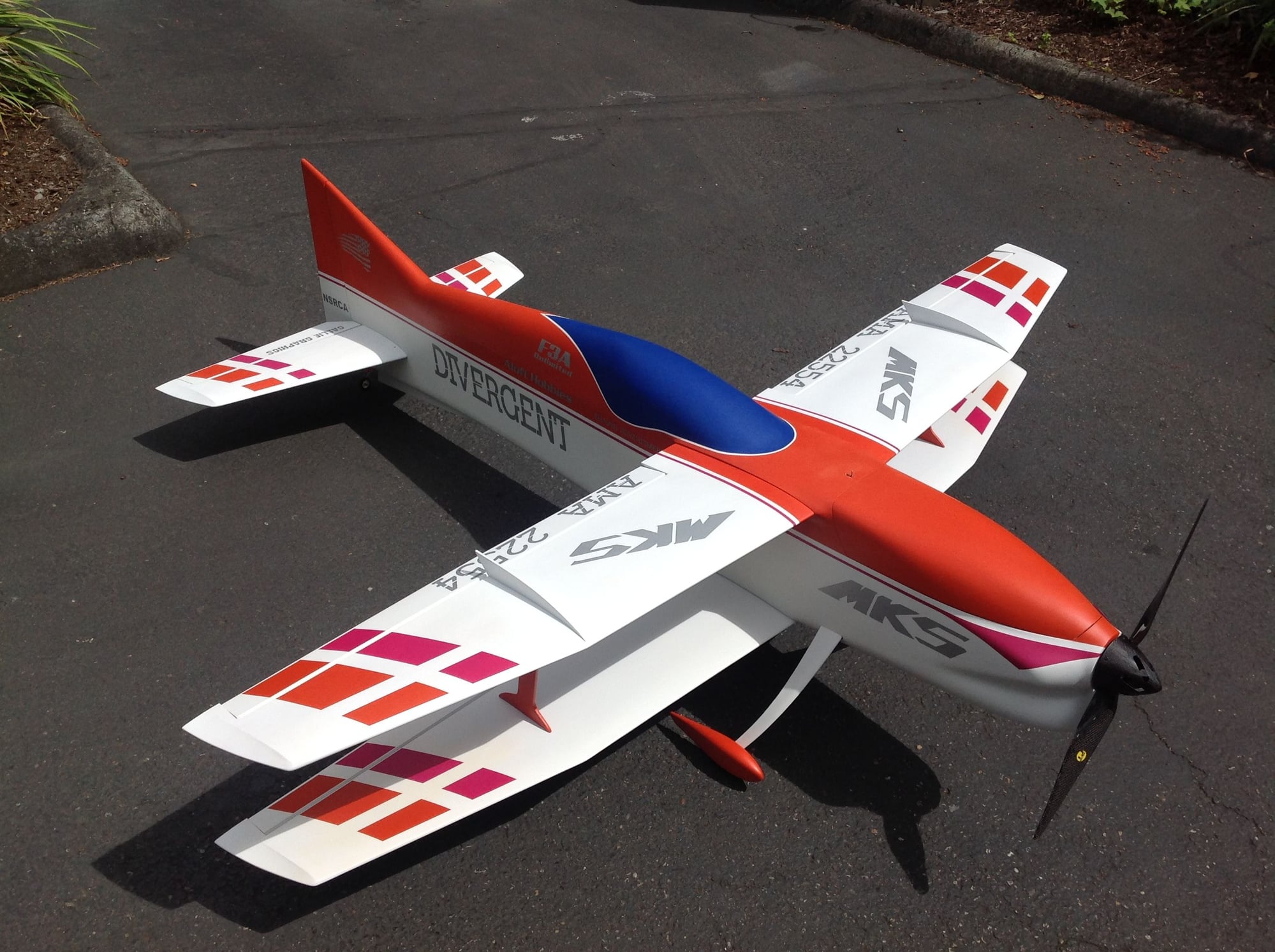
1.9 meter span F3A airplane. The wings, stabilizers and rudder were made as described. Model uses a 3,000 watt 10S electric power system. RTF weight is 4,500g.

1.9 meter span F3A airplane. The wings, stabilizers and rudder were made as described. Model uses a 3,000 watt 10S electric power system. RTF weight is 4,500g.
#3
Banned
Thread Starter
speedracerntrixie, thanks for the feedback. I find it very usefull.
And by the way, ... nice plane!!
And by the way, ... nice plane!!
#4

speedracerntrixie summarised the most common way to do this. I've built MANY foam core wing planes using this method, and it works very well. With care, it can be lighter than a built up balsa wing.
Choose your glue with a bit of care. Foam safe spray contact cement can be used....but it is susceptible to high temps. A black wing in a hot car may not come out of the car in the same shape as it went in.....
Good old Titebond yellow glue works well. A thin coat on the wood, another on the foam and let dry. Then use your covering iron to literally iron the balsa on to the wing. The heat polymerizes the glue, and forms a bond that will be as strong and as permanent as epoxy.
Thin Gorilla Glue with acetone, and paint a very thin coat on the balsa. Wait for the acetone to flash off (only a few minutes), then apply sheeting, weight, and allow to dry overnight.
The biggest enemy is too much glue - that is what adds weight.
There was a "fad" at one time to either cut out holes in the foam cores, in the balsa skins, or both to save weight. In my cases, the weight saving were very, very minimal, considering all the extra work.
Choose your glue with a bit of care. Foam safe spray contact cement can be used....but it is susceptible to high temps. A black wing in a hot car may not come out of the car in the same shape as it went in.....
Good old Titebond yellow glue works well. A thin coat on the wood, another on the foam and let dry. Then use your covering iron to literally iron the balsa on to the wing. The heat polymerizes the glue, and forms a bond that will be as strong and as permanent as epoxy.
Thin Gorilla Glue with acetone, and paint a very thin coat on the balsa. Wait for the acetone to flash off (only a few minutes), then apply sheeting, weight, and allow to dry overnight.
The biggest enemy is too much glue - that is what adds weight.
There was a "fad" at one time to either cut out holes in the foam cores, in the balsa skins, or both to save weight. In my cases, the weight saving were very, very minimal, considering all the extra work.
#5
Banned
Thread Starter
tedsander
It's clear and makes sense all instructions to me. I trust it is a good/proven technique.
Using acetone to thin the glue makes sense to me but I would like to ensure I did not missunderstand. The paint with thinned coat is used on the balsa before ironing it on the foam core - is this corerect?
For cutring after sheeting for curing I plan to vacuum bag the wing .
Thanks
It's clear and makes sense all instructions to me. I trust it is a good/proven technique.
Using acetone to thin the glue makes sense to me but I would like to ensure I did not missunderstand. The paint with thinned coat is used on the balsa before ironing it on the foam core - is this corerect?
For cutring after sheeting for curing I plan to vacuum bag the wing .
Thanks
#6

Thin Gorilla Glue with acetone. Only paint it on the balsa (acetone will melt the foam). But the acetone will evaporate pretty quickly, leaving just a thin layer of glue behind. No need to iron, just put the skin on, weight it down, or vacuum bag, so it has good contact with the foam all over, and wait until the next day.
Use the iron for the Titebond version. Make sure to put a thin coat on both surfaces and let it dry completely. You can use an old credit card or similar to help spread it evenly or thinly (same with epoxy). If using this method, do one side at a time, flat in the blocks the cores came out of, so you don't introduce any twist as you iron the sheeting on. You will have to turn the iron up pretty hot, and go slowly, so the heat penetrates the wood to the glue. Do a test run or two on some scrap balsa/foam to get the sense of it, but it's not at all difficult. Just be aware that once you've started, the areas you heat will be permanent. Reheating won't loosen them up again. You could use a little bit of water to thin the glue, to make it more spreadable...but don't use much, or it will make the balsa swell/warp, making it harder to get it down. More hand work with the iron, but then you won't need to vacuum bag or wait for the glue to set like Gorilla or Epoxy.
Use the iron for the Titebond version. Make sure to put a thin coat on both surfaces and let it dry completely. You can use an old credit card or similar to help spread it evenly or thinly (same with epoxy). If using this method, do one side at a time, flat in the blocks the cores came out of, so you don't introduce any twist as you iron the sheeting on. You will have to turn the iron up pretty hot, and go slowly, so the heat penetrates the wood to the glue. Do a test run or two on some scrap balsa/foam to get the sense of it, but it's not at all difficult. Just be aware that once you've started, the areas you heat will be permanent. Reheating won't loosen them up again. You could use a little bit of water to thin the glue, to make it more spreadable...but don't use much, or it will make the balsa swell/warp, making it harder to get it down. More hand work with the iron, but then you won't need to vacuum bag or wait for the glue to set like Gorilla or Epoxy.
#7
Banned
Thread Starter
Clear now. Appreciate the help. For the next couple of days I'll do some tests with both Gorilla glue and Titebond. Will find which of variants I can get better result from.
#8
I learned not to core out foam wings to try and lighten them. I cored them out and then skinned them. Vacuum bagged. The vacuum sucked the balsa skins down into the voids where the foam had been cored out beneath. When I released the vacuum the surface of the skins was all concave down in between the ribs.
I salvaged the wings by cutting the balsa out of the voids.
If I was gonna core out a foam wing panel again, I'd cut my sheeting exact so none of it spanned across the void spaces..... or just use weights and forget about the vacuum.
I salvaged the wings by cutting the balsa out of the voids.
If I was gonna core out a foam wing panel again, I'd cut my sheeting exact so none of it spanned across the void spaces..... or just use weights and forget about the vacuum.
#9
Banned
Thread Starter
I estimated if I cut the wings from 20kg/m^3 density white foam, the total weight of the foam is 65 grams. So I wander it makes sense to complicate the build for that small.
#10
Elsewhere, difficulties getting very light balsa have been discussed. A popular solution has been to use thinner sheets of heavier and stronger balsa.
#12
Banned
Thread Starter
About applying glue in strips I am not sure. In time, the wood with/without glue would behave different.
Thinning the glue seems better alternative to ensure minimal glue quantities are used. It can be used normal glue to edges and where more strength is required.
Now I wander is there alternatives to using heatshrinck foils ( oracover or other ) that I am not aware? I know painting would work on fiber glass laminate but not for balsa sheeting.
Thinning the glue seems better alternative to ensure minimal glue quantities are used. It can be used normal glue to edges and where more strength is required.
Now I wander is there alternatives to using heatshrinck foils ( oracover or other ) that I am not aware? I know painting would work on fiber glass laminate but not for balsa sheeting.
Last edited by critx; 11-16-2020 at 12:42 PM.
#13

With care, a painted wing can be lighter than a film covered wing. But one has to be very attentive to the quantity applied, and it can take a long time, with drying/sanding/etc. It is the preferred way for many Master level builders. All depends on the level you want to take it to, the time you have available, and the investment in tools/materials you are willing to make.
The old stand-by:
Cover the wing with very light (1/4 oz) fiberglass cloth.
Squeegee on epoxy finishing resin to bond the cloth to the balsa.
Roll the surface with a roll of TP, discarding layers as needed. The goal is to soak up as much as the excess epoxy as possible, to avoid weight build up.
Let dry.
Fill the weave with filler - may be primer, concoctions of dope and talcum powder or other materials.
Sand it all down, being careful to get as much filler removed as you can, without cutting into the fiberglass.
Repeat as needed to get a super smooth finish, with the most minimum amount possible.
Prime and sand, if needed.
Spray paint, sanding as needed between coats.
Spray clear (if needed), sanding as needed.
I've compressed it all, and skipped finer points..but google will lead you to much more complete instructions.
On planes I don't really care about for appearance or weight, I've just sealed the wood with epoxy, and then used house paint. But the wood soaks up a lot, and house paint can be very heavy.....
One of my fellow club members is a Master, and will only use dope. His results are jaw dropping, and exceptionally light. But that is a whole 'nother level of time invested in many coats and hours of sanding....
The old stand-by:
Cover the wing with very light (1/4 oz) fiberglass cloth.
Squeegee on epoxy finishing resin to bond the cloth to the balsa.
Roll the surface with a roll of TP, discarding layers as needed. The goal is to soak up as much as the excess epoxy as possible, to avoid weight build up.
Let dry.
Fill the weave with filler - may be primer, concoctions of dope and talcum powder or other materials.
Sand it all down, being careful to get as much filler removed as you can, without cutting into the fiberglass.
Repeat as needed to get a super smooth finish, with the most minimum amount possible.
Prime and sand, if needed.
Spray paint, sanding as needed between coats.
Spray clear (if needed), sanding as needed.
I've compressed it all, and skipped finer points..but google will lead you to much more complete instructions.
On planes I don't really care about for appearance or weight, I've just sealed the wood with epoxy, and then used house paint. But the wood soaks up a lot, and house paint can be very heavy.....
One of my fellow club members is a Master, and will only use dope. His results are jaw dropping, and exceptionally light. But that is a whole 'nother level of time invested in many coats and hours of sanding....
#15
Banned
Thread Starter
I did a test gluing 1.5mm ( 1/16 ) balsa on a foam core wing section using Gorilla glue and result is nice.
I actually have some 17 grams fiberglass and will start with a small test see what comes out.
@speedracerntrixie that would be really appreciated.
I actually have some 17 grams fiberglass and will start with a small test see what comes out.
@speedracerntrixie that would be really appreciated.
#16

My Feedback: (29)
Then I will post some pictures and descriptions. I have tried Gorilla glue before and agree that if not using a vacuum bag system it is a very good way to go. Just a little heavier then epoxy. My only complaint is that you are time limited as it starts to foam quickly. With my epoxy system I have over an hour working time. I can also fix any slight warps should they occur.
#18

Join Date: Oct 2002
Location: Chilliwack, BC, CANADA
Posts: 12,425
Likes: 0
Received 22 Likes
on
19 Posts
I learned not to core out foam wings to try and lighten them. I cored them out and then skinned them. Vacuum bagged. The vacuum sucked the balsa skins down into the voids where the foam had been cored out beneath. When I released the vacuum the surface of the skins was all concave down in between the ribs.
I salvaged the wings by cutting the balsa out of the voids.
If I was gonna core out a foam wing panel again, I'd cut my sheeting exact so none of it spanned across the void spaces..... or just use weights and forget about the vacuum.
I salvaged the wings by cutting the balsa out of the voids.
If I was gonna core out a foam wing panel again, I'd cut my sheeting exact so none of it spanned across the void spaces..... or just use weights and forget about the vacuum.
Just for giggles.... Let's say you cut away a 2x3 cutout. That's 6 square inches. Even with my light duty limited 2PSI of vacuum that's 12 lbs pushing in on the balsa.
Critx, you might try using an old outdated credit card or similar to spread the polyurethane (Gorilla Glue) around without thinning it. The stuff spreads pretty easily if you move it with pressure and a lazy speed. That way there's no risk at all of the glue having any acetone in it.
I believe that it's also a fairly common step to wipe the foam core down with a damp cloth. You don't want it fully wet but a touch of moisture helps the PU glue foam more and fill the voids. Otherwise you're relying on moisture in the balsa. And that ain't much usually.
For the smaller models you really should get some very light wood. Something around the 5 to 7 lb density range. There's a few charts and tables online you can search for to use along with a digital scale to weigh the sheets you have and determine their density. But if you can use this 5 to 7 lb wood and don't go crazy with the glue the method even on smaller models can be very successful.
#19
Banned
Thread Starter
In 2012 if I well remember I build a 1.2m flying wing that was foam core + balsa sheeting + oracover and went little heavy but it was flying very well. So questions here was to find ways to improve that process I used.
I've done some tests in last couple of days.
I used Gorilla Wood glue - This Gorilla glue is not really popular in my area, I can only ffind it in one shop. From your message I figured out it is actually a PU Gorilla glue that you use. Locally we have that PU glue under "Bison" brand, easy to find in any shop.
I also find foam with density of 14kg/m^3 , I think that may work well if I am carefull with the amount of glue used.
I've done some tests in last couple of days.
I used Gorilla Wood glue - This Gorilla glue is not really popular in my area, I can only ffind it in one shop. From your message I figured out it is actually a PU Gorilla glue that you use. Locally we have that PU glue under "Bison" brand, easy to find in any shop.
I also find foam with density of 14kg/m^3 , I think that may work well if I am carefull with the amount of glue used.
#21

My Feedback: (29)
OK a single promised, pictures of glassing a set of stabs.

3/4oz cloth placed on surface and smoothed out.
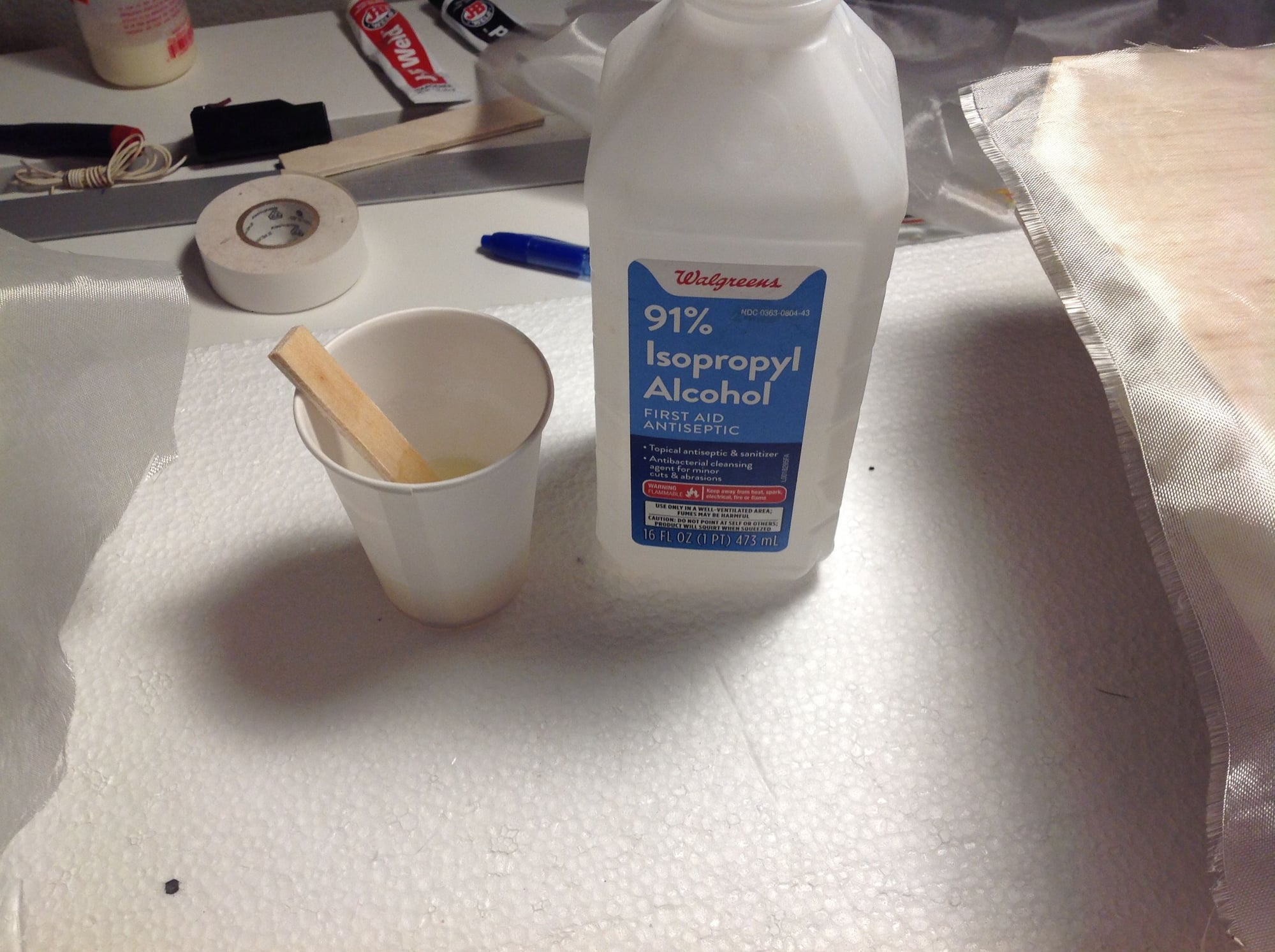
20 grams of mixed epoxy laminating resin is reduced with 3 grams of alcohol.

Drizzle some resin on the cloth.
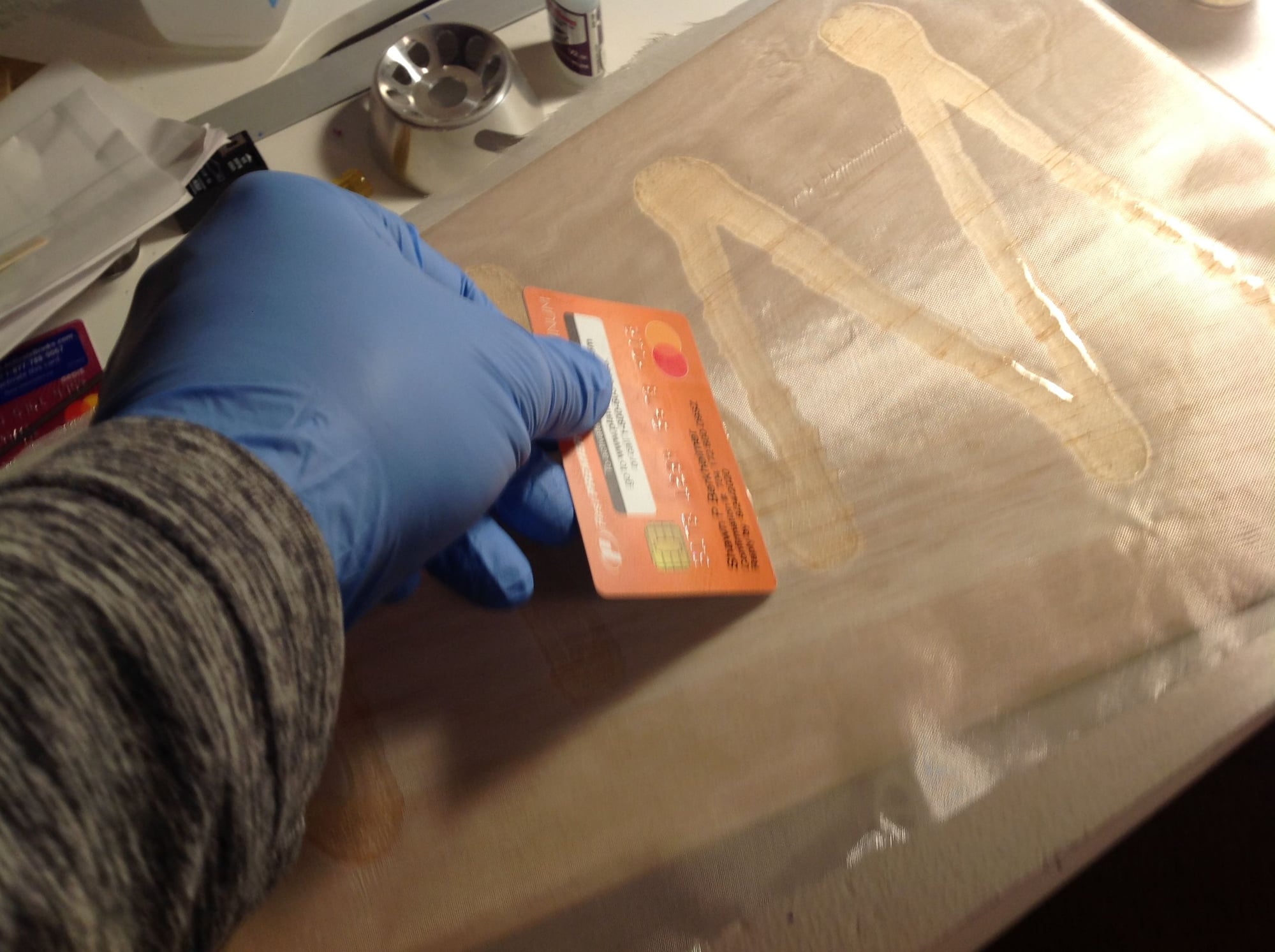
Squeegee/saturate the cloth with an old credit card or simular.

The cloth has been wet out.
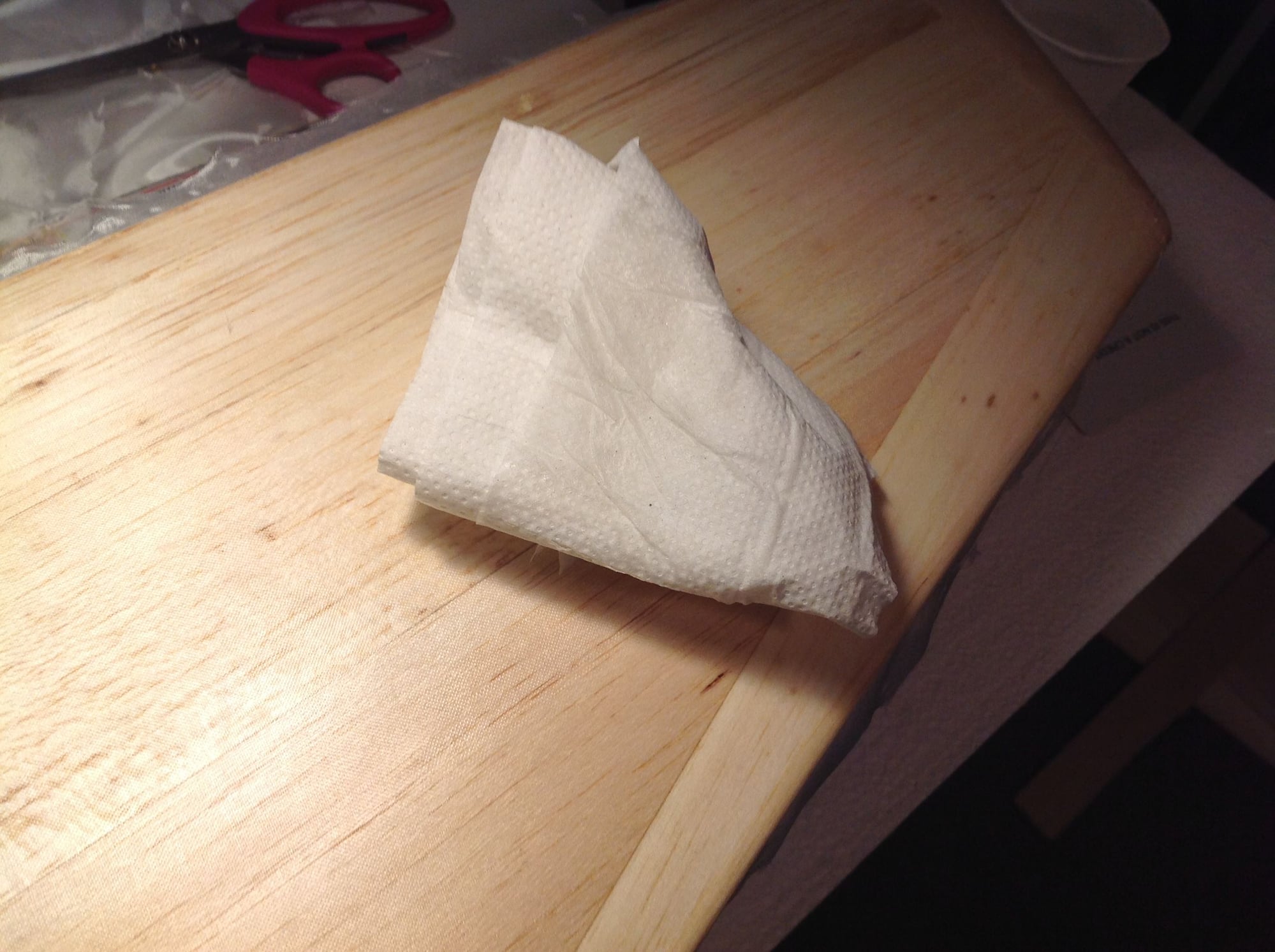
Last step is to blot off any excess resin. Starting weight of the stabs was 70 grams each, after glassing 80 grams. Stab combined span is 36".

3/4oz cloth placed on surface and smoothed out.

20 grams of mixed epoxy laminating resin is reduced with 3 grams of alcohol.

Drizzle some resin on the cloth.

Squeegee/saturate the cloth with an old credit card or simular.

The cloth has been wet out.

Last step is to blot off any excess resin. Starting weight of the stabs was 70 grams each, after glassing 80 grams. Stab combined span is 36".
#22

My Feedback: (29)
Thought thus may be of some interest. This is a section removed from a wing recently. The sheeting was applied using epoxy laminating resin and vacuum bagged. In order to get even pressure, I place the sheeted cores back into the shucks and then add 1/4" MDF to the outside of the shucks. Once vacuum is pulled the stack up gets even pressure that leads to straight wings but if the cores have cut outs for lightening or servos the sheeting will not get sucked in.
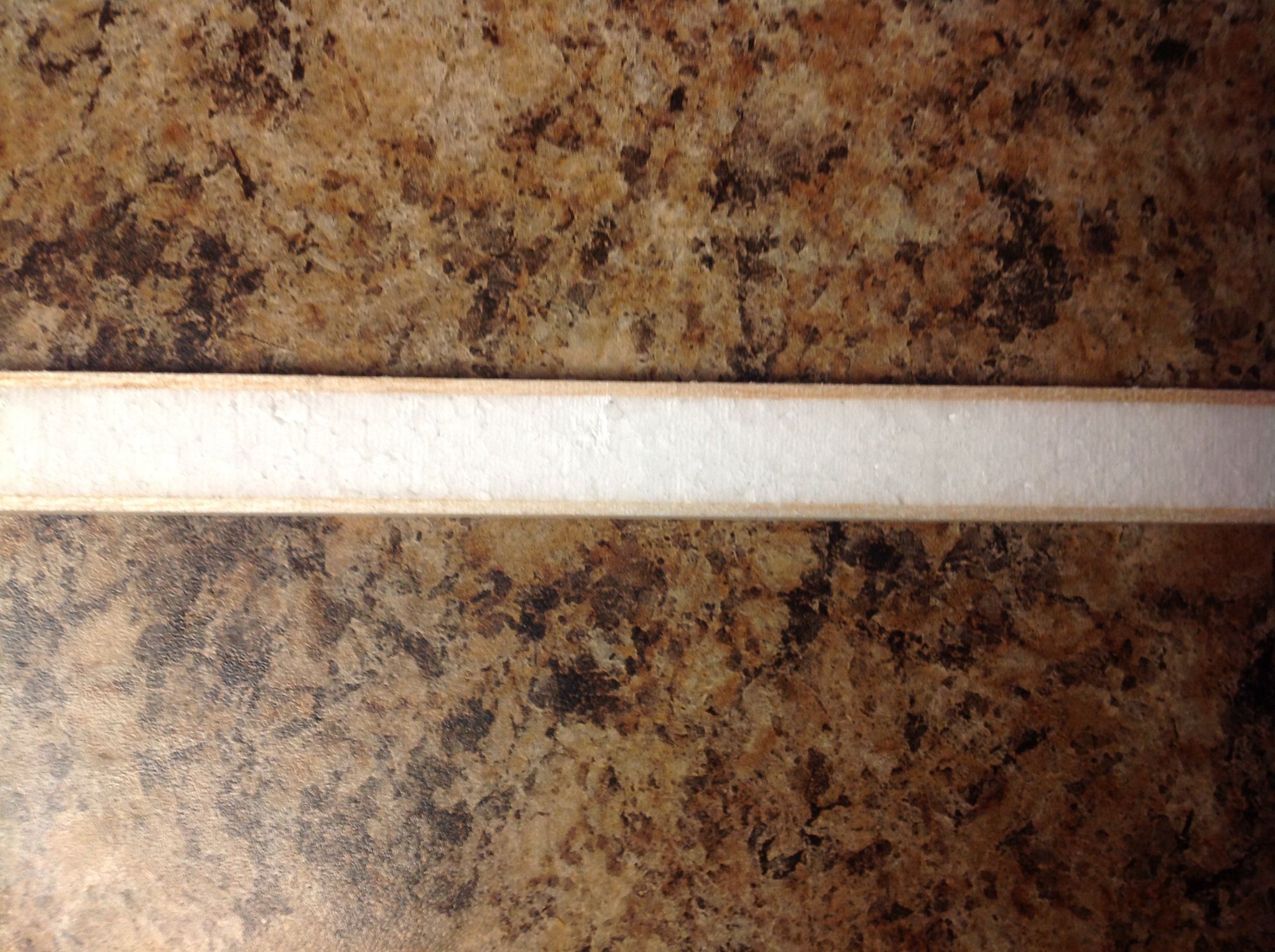

#23
Banned
Thread Starter
Sorry for my late answer. My medical condition and surgery that is planned in two weeks will make me postpone this build until in the spring next year.
The sheeting on your part looks really good and even. I still plan to use PU glue as I find it easier for me to work and supply as well.
The sheeting on your part looks really good and even. I still plan to use PU glue as I find it easier for me to work and supply as well.
#24
Banned
Thread Starter
@speedracerntrixie
I'm curiouse do you add any carbon or wood spars to stregten the wing?
Or is it fine a 48" wingspan without?
By the way I'm back, not yet able to go in the workshop but preparing for it.
Thanks,
I'm curiouse do you add any carbon or wood spars to stregten the wing?
Or is it fine a 48" wingspan without?
By the way I'm back, not yet able to go in the workshop but preparing for it.
Thanks,




